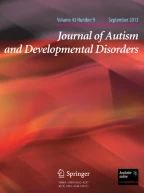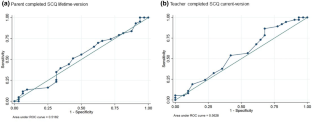Brief Report: An Evaluation of the Social Communication Questionnaire as a Screening Tool for Autism Spectrum Disorder in Young People Referred to Child & Adolescent Mental Health Services

The SCQ is a widely used screening measure for the assessment of autism spectrum disorder (ASD). However, its sensitivity and specificity when used with older children in the context of community Child & Adolescent Mental Health services is unclear. Seventy-seven (Mean age = 12.8 years) young people with suspected ASD were screened using parent- and teacher-reported SCQ’s before completing a comprehensive diagnostic assessment. Of the 77 young people included, 44 (57%) met criteria for an ASD diagnosis. Our results indicated that regardless of informant, SCQ scores did not significantly predict the outcome of the diagnostic assessment. Based on the published cut-off score for the SCQ, Receiver Operating Characteristic curve analyses revealed a lower than expected sensitivity and specificity. This suggests that the SCQ is not an effective screening tool when used in the context of community Child & Adolescent Mental Health services.
This is a preview of subscription content, log in via an institution to check access.
Access this article
Subscribe and save
Springer+ Basic
€32.70 /Month
- Get 10 units per month
- Download Article/Chapter or eBook
- 1 Unit = 1 Article or 1 Chapter
- Cancel anytime
Buy Now
Price includes VAT (France)
Instant access to the full article PDF.
Rent this article via DeepDyve

References
- Allen, C. W., Silove, N., Williams, K., & Hutchins, P. (2007). Validity of the social communication questionnaire in assessing risk of autism in preschool children with developmental problems. Journal of Autism and Developmental Disorders, 37(7), 1272–1278. ArticlePubMedGoogle Scholar
- Berument, S. K., Rutter, M., Lord, C., Pickles, A., & Bailey, A. (1999). Autism screening questionnaire: diagnostic validity. British Journal of Psychiatry, 175(5), 444–451. ArticlePubMedGoogle Scholar
- Bishop, D. V. M. (1998). Development of the children’s communication checklist (CCC): a method for assessing qualitative aspects of communicative impairment in children. Journal of Child Psychology and Psychiatry and Allied Disciplines, 39(6), 879–891. ArticleGoogle Scholar
- Boyko, E. J. (1994). Ruling out or ruling in disease with the most sensitive or specific diagnostic test: short cut or wrong turn? Medical Decision Making, 14(2), 175–179. ArticlePubMedGoogle Scholar
- Charman, T., Baird, G., Simonoff, E., Loucas, T., Chandler, S., Meldrum, D., … Pickles, A. W. (2007). Efficacy of three screening instruments in the identification of autistic-spectrum disorders service. The British Journal of Psychiatry, 39, 554–559. ArticleGoogle Scholar
- Chesnut, S. R., Wei, T., Barnard-Brak, L., & Richman, D. M. (2016). A meta-analysis of the social communication questionnaire: screening for autism spectrum disorder. Autism, 21(8), 920–928. ArticlePubMedGoogle Scholar
- Constantino, J. N., & Gruber, C. P. (2012). Social responsiveness scale, 2nd edition. Torrance, CA: Western Psychological Services. Google Scholar
- Corsello, C., Hus, V., Pickles, A., Risi, S., Cook, E. H., Leventhal, B. L., & Lord, C. (2007). Between a ROC and a hard place: decision making and making decisions about using the SCQ. Journal of Child Psychology and Psychiatry and Allied Disciplines, 48(9), 932–940. ArticleGoogle Scholar
- Goodman, R. (1997). The strengths and difficulties questionnaire: a research note. Journal of Child Psychology and Psychiatry, 38(5), 581–586. ArticlePubMedGoogle Scholar
- Hanley, A. J., & McNeil, J. B. (1982). The meaning and use of the area under a receiver operating characteristic (ROC) curve. Radiology, 143, 29–36. ArticleGoogle Scholar
- Hus, V., & Lord, C. (2014). The autism diagnostic observation schedule, module 4: revised algorithm and standardized severity scores. Journal of Autism and Developmental Disorders, 44(8), 1996–2012. ArticlePubMedPubMed CentralGoogle Scholar
- Lord, C., Risi, S., DiLavore, P. S., Shulman, C., Thurm, A., & Pickles, A. (2006). Autism From 2 to 9 Years of Age. Archives of General Psychiatry, 63(6), 694. ArticlePubMedGoogle Scholar
- Lord, C., Risi, S., Lambrecht, L., Cook, E. H., Leventhal, B. L., DiLavore, P. C., … Rutter, M. (2000). The autism diagnostic observation schedule-generic: a standard measure of social and communication deficits associated with the spectrum of autism. Journal of Autism and Developmental Disorders, 30, 205–223. ArticlePubMedGoogle Scholar
- Lord, C., Rutter, M., & Le Couteur, A. (1994). Autism diagnostic interview-revised: a revised version of a diagnostic interview for caregivers of individuals with possible pervasive developmental disorders. Journal of Autism and Developmental Disorders, 24, 659–685. ArticlePubMedGoogle Scholar
- Mandell, D. S., Novak, M. M., & Zubritsky, C. D. (2005). Factors associated with age of diagnosis among children with autism spectrum disorders. Pediatrics, 116(6), 1480–1486. ArticlePubMedPubMed CentralGoogle Scholar
- Rutter, M., Bailey, A., & Lord, C. (2003). The social communication questionnaire. Los Angeles: Western Psychological Services. Google Scholar
- Salazar, F., Baird, G., Chandler, S., Tseng, E., O’sullivan, T., Howlin, P., … Simonoff, E. (2015). Co-occurring psychiatric disorders in preschool and elementary school-aged children with autism spectrum disorder. Journal of Autism and Developmental Disorders, 45(8), 2283–2294. ArticlePubMedGoogle Scholar
- Schanding, G. T., Nowell, K. P., & Goin-Kochel, R. P. (2012). Utility of the social communication questionnaire-current and social responsiveness scale as teacher-report screening tools for autism spectrum disorders. Journal of Autism and Developmental Disorders, 42(8), 1705–1716. ArticlePubMedGoogle Scholar
- Simonoff, E., Pickles, A., Charman, T., Chandler, S., Loucas, T., & Baird, G. (2008). Psychiatric disorders in children with autism spectrum disorders: prevalence, comorbidity, and associated factors in a population-derived sample. Journal of the American Academy of Child and Adolescent Psychiatry, 47, 921–929. ArticleGoogle Scholar
- Snow, A. V. L. L. (2008). Sensitivity and specificity of the modified checklist for Autism in toddlers and the social communication questionnaire in preschoolers suspected of having pervasive developmental disorders. Autism, 12(6), 627–644. ArticlePubMedGoogle Scholar
Acknowledgments
The authors would like to thank all clinical staff within the Cambridgeshire & Peterborough NHS foundation trust, Child and Adolescent Mental Health Service who took the time to record the data used in this study.
Author information
Authors and Affiliations
- Department of Clinical Psychology, University of East Anglia, Norwich, NR47TJ, UK Matthew J. Hollocks & Peter Beazley
- Child Development Centre, Hillingdon Hospital, Central and North West London NHS Foundation Trust, London, UK Matthew J. Hollocks
- Cambridgeshire and Peterborough NHS Foundation Trust, Cambridge, UK Roland Casson, Clare White, Jess Dobson & Ayla Humphrey
- Department of Psychiatry, University of Cambridge, Cambridge, UK Ayla Humphrey
- Matthew J. Hollocks


